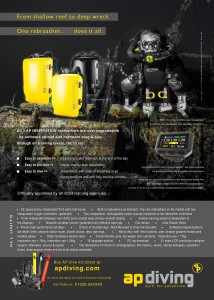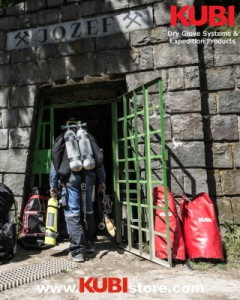DICTIONARY OF EGYPTIAN SHIPWRECKS H
DICTIONARY OF EGYPTIAN SHIPWRECKS- H
FURTHER DETAILS CAN BE DOWNLOADED FROM
www.KUBIstore.com & www.Miflexhoseshop.co.uk
M.V.HAMADA
The M.V HAMADA was a small cargo ship of 654 GRT built at John Lewis & Sons Ltd.(Yard No. 347), Aberdeen, UK for the P & O subsidiary company General Steam Navigation Co., Ltd. The ship was launched on 15 March 1965 as the Avocet (Registry No. 651078) and was completed on 12 June of that same year with a length of 65.10 meters, beam of 11.07 meters, and draught of 4.05 meters. Propulsion was provided by a single 1,470 bhp MN17 type diesel manufactured by British Polar Engine Ltd., Glasgow, Scotland, and a single propeller for a speed of 12.5 knots.
From the time of her launching in 1965 until late 1971, the Avocet was operated in the coastal waters of the UK by the General Steam Navigation Co. On 01 October 1971 management and operation of the ship was transferred to another P & O subsidiary company call P & O Short Sea Shipping Ltd. Then, on 01 December 1972, ownership of the ship was transferred to General Steam Navigation (Trading) Ltd. Management and operation were transferred once again on 31 March 1975 to the P & O Ferry Line until 16 June 1976 when ownership was transferred to P & O Ferry’s General European Ltd.
On 22 June of that same year the ship was sold to Stavros Elias Liakos Maritime Ltd., Cyprus, and renamed the Afroditi H, and then was resold to the Euromaster Navigation Co. Ltd., Cyprus.
In 1982 the ship was renamed Samarah and then was sold to Leghorn Shipping Co. Ltd., Cyprus in 1983 where she operated for nearly two years before being sold yet again.
In 1985, the ship was sold to the Chaldean Shipping Co. Ltd., Cyprus and renamed Hamada. A year later, in 1986, the Hamada was sold to the Phemios Shipping Co., Valetta, Malta.
There are different versions of the Hamada’s loss. One report indicates that she caught fire and sank in deep water. The P & O file states that the ship struck an “submerged object” in heavy weather at position 24.42N/35.25E off of Ras Banas while enroute on 28 June 1993 from Jeddah to Suez and subsequently foundered
|
|
THE ENIGMA.
The Hamada was a small coastal general cargo vessel, which was carrying a cargo of plastic graduals, out of Yambo Saudi Arabia. The official report stated that she caught fire and sank in deep water. However another report states “No.2 hold was flooded as bottom shell plating came into contact with submerged object.”- So why the charred mattress?. Her cargo doors were wide open and all personal effects and tools had gone………………………….
THE WRECK TODAY
Lying in only 12 mtrs of water half a mile south of the phosphate terminal of Abu Gosoon, the wreck is now broken in two with her holds facing the reef a few meters away. The holds are beginning to collapse The stern section, complete with superstructure has slipped further away from the reef. The interior can be penetrated and it is possible to explore the mess room, accommodation and the engine room, although the latter needs great care. Over the years soft corals have taken hold and the port companionway is smothered in lush soft corals of purple, red and orange. These in turn support a healthy mixture of reef fishes and invertebrates- seven specie of nudibranchs were noted by one bug hunter.
Her port side is awash at low tide and the water can be as much as 31degrees above her hull in summer. Some of her cargo, bagged polythene granules, a by product of the petro-chemical industry, remains in the hold, in an eternal struggle to reach the surface. The bow section has broken away from the aft section and lies slightly further down the reef from its original position is quite impressive complete with anchors and the fo’csle contains a forklift truck as well as the anchor windlass and winches.
Another wheeled but tyre-less vehicle lies upside down in the sand, between the wreck and the reef. It appears to be another type of fork lift truk. The masts lie resting in the reef slope complete with cables and pulleys Marine life is slowly moving into the wreck, hard corals having established themselves in the hull, masts and deck, visibility can be down after strong winds, due to the sandy, shallow bottom and the site is subject to swell. It is how ever an excellent dive when the right conditions apply..
Despite the high temperatures of the water, soft corals have thrived and totally colonised the wreck, no more so that the upper companionways, stairways and hatches. It is a living reef and highly populated with many species of reef fishes and visiting hunters. Being so shallow the colour are vibrant, and the entire wreck is simply a photo studio. The visibility can be reduced during windy conditions due to the sandy sea bed. However the conditions are usually favourable, and afford wide angle opportunities. With the emergence of shore based dive centres, the wreck attracts less qualified divers, often diving the wreck from the shore.It tends to be the final dive in our wreck safari before the long barren drag back to Port Galib
The stern appears just as it did back in 1995, while the fore section has broken off ad slipped down the slope slightly. It is a magnificent sight, bathed in strong natural light 10.5mm lens is a must!
HDML 1015:
The HDML 1015 was a 54 Grt. Harbour Defense Motor Launch (HDML) built at M.W. Blackmore & Sons, Bideford, N. Devon, UK. for the British Royal Navy. One of 486 of this vessel type built during WWII, she was launched on 24 February 1941, with a length of 22 meters, beam of 4.9 meters, and a draught of 1.5 meters fully loaded. Propulsion was provided by two Gardner 8L3 diesel engines providing 204 bhp to twin shafts for a top speed of 12 knots, with a range of 2000 miles at 10 knots cruising speed. Design criteria required that the boat have a turn radius of that of a surfaced submarine. This resulted in the installation of two large rudders and the keel ending 13-feet from the boat’s stem. Crew compliment was 2 officers, 2 petty officers, and 6 ratings.
Armament for the HDML’s was typically twin 20mm Oerlikon guns, twin Vickers “K” machine guns, and 6 depth charges. As well as any assortment of small arms which the boat’s crews could procure on their own.
Boats were initially shipped to foreign stations on board ships. However, later in the war when cargo space became scarce, many of these vessels made their own was as far a Iceland, Gibralter, and the Mediterannean. Boats serving in the Med. and in tropical waters had their hulls sheathed in copper below the waterline to prevent damage by Toredo Navalis (wood boring worms).
After launching, the HDML 1015 departed Devon in March 1941 to Clyde (Holy Loch) via Hamble, Appledore, and Holyhead for transport via ship to the Mediterannean. While enroute, the boat collided with a bouy while departing Appledore without suffering serious damage.
In May 1941 the HDML 1015 was placed onboard the S.S. Belpareil and departed on the 31st as part of Convoy OB-329 for Suez via Durban, South Africa. The convoy is dispersed on 05 June and the S.S. BelPareil steamed independently to Suez via Freetown, Capetown, Mombasa, Aden, Massawa, and Port Sudan, as well as other ports. Arriving at Suez 18 August 1941, the HDML 1015 is offloaded
The HDML 1015 then joined the 102nd Motor Launch Flotilla at Alexandria, Egypt on 01 January 1942. This flotilla consisted of the motor launches ML 1012, ML 1017, ML 1023, ML1038, ML1039, and ML 1051.
In October 1943 the HDML 1015 was lost in heavy weather near Alexandria.
M.V. HEBAT ALLAH
The wreck now lies in 46 mtrs between Giftun Island and Gotta Abu Ramada, on a flat seabed of sand and broken coral heads. Her fore and aft masts reach up to 26mtrs.
With her superstructure situated aft, the first view on the decent is the top of the bridge an 36 mtrs with the funnel and derricks just behind………..
Before she was sunk she was lined out and exit arrows put in place, and with numerous doors and stair wells there are great opportunities for safe penetration and exploration. The bridge has good natural light with windows on three sides and access to the engine room is from the rear of the bridge. Large groupers and morays eels have already laid claim to the new accommodation on offer.
The deck is at 40 mtrs and the two holds are empty at present. I suspect once word gets round they will also become a haven for marine life. A single door at the fo’s’cle bulkhead offers another opportunity for safe penetration.
M.V. HEY DAROMA
Much of the M V HEY DAROMA is now under the hull of the Million Hope but her engine, Shafts and plates etc can be snorkelled, just of the starboard bow..
H.M.S. HEYTHROP
The 1050 ton British destroyer was built in 1940 at Vickers Armstrong she was fitted with turbine engines delivering 19,00nhp and could make 27 knots. She was 272 ft long and armed with four 4 inch AA guns and 8 other smaller guns. She was a Hunt Class, type11
After an initial working up period at Scapa and in the Irish Sea, she arrived at Gibraltar in August 1941 where she underwent minor repairs. On 13 September, she went to sea with the Gibraltar local escort force covering the cruiser HMS Manchester and the destroyer HMS Firedrake, en route to the U.S.A. as far as 25° West. On 25 September, she joined the heavy forces assembled in Gibraltar Strait to cover a convoy to Malta during Operation Halberd. Two days later, the British merchant steamship Imperial Star was torpedoed by German aircraft north of Cape Bon, HMS Heythrop took off 300 soldiers arriving at Malta on 28 September. The ship immediately left as part of a force escorting three merchant empty ships in ballast back to Gibraltar. Early in October, HMS Heythrop sailed via South Africa for Alexandria, arriving on 15 November, where she joined the 2nd Destroyer Flotilla and took part in two offensives in Lybia.
From November 1941 to January 1942, the destroyer made several sortiesfrom Alexandria to Tobruk, constantly under attacks by enemy torpedo bombers. She made her last run to Tobruk on 30 January 1942, escorting the steam merchant Antwerp (carrying 370 personnel) and returned to Alexandria seven days later.
At 1054hours on 20 March 1942, HMS Heythrop was hit by one of four torpedoes from U-652 about 40 miles northeast of Bardia and was then taken in tow by the British destroyer HMS Eridge towards Tobruk, but foundered five hours later, with he loss of 16 ratings. She was under the command of Lt Cdr R S Stafford Malta convoy
S.S. HURRIET.
THE SHIP.
Built in 1882 as the PETROPLOIS for the Hamburgh.Sud.AmericaDampfs.Gesells Co., she was a 2002 ton iron steamship, built in Hamburgh by Reinast’g Schiffsw.She was 285 ft long with a 25ft beam and compound 2 cylinder steam engines delivering 90nhp.She was responsible for sinking the VALUTA in thick fog of the south coast of England, In 1890 she became the PERGAMON, until 1896 when she took on her final name as the HURRIET.
Her career came to an end at EL TOR, on the SINAI COAST of the Gulf of Suez, when she caught fire-news reports of the time her detail her demise;
“Constantinople, Feb. 24. – According to an unconfirmed newspaper report, the Turkish steamer Hourriet, which was transporting Moslem pilgrims, has been burned at sea. All on board are stated to be lost. – Reuter.”
“Constantinople, Feb. 24. – The Steamship Agency confirms the destruction of the Hourriet by fire at the quarantine station at El Tor, but denies that there was any loss of life.- Reuter.”
“Port Said, Feb. 27. – Hourriet (s), reported completely gutted, abandoned. Your special officer proceeding. – Salvage Association.”
(Shipping gazette .. . . March 3 1911 )
“Suez, Feb. 28. – Hourriet (s): Your special officer wires ship gutted, main and upper wooden decks entirely consumed, upper iron deck forward collapsed, fallen eight feet, pulling in ships sides three feet, main engines, boilers, practically intact. Ship making little water, has settled one foot since yesterday, leakage will undoubtedly increase as ship settles. Aida sending hand pump reduce water which will make ship safe for four or five days. After pumping out we return Suez. Egyptian Government ought to intervene promptly. – Salvage Association.”
(Shipping gazette .. . . March 3 1911 )
“Suez, March 2. – Hourriet (s): The telegraph cable to El Tor is out of order, impossible to obtain any news, cannot communicate with your special officer. Danmark available, shall we make arrangements tow Suez? “Aida,” Egyptian Government vessel, standing by. – Salvage Association.”
Suez, March 4. – No immediate danger to ship. – Salvage Association’s Special Officer.”
(Shipping gazette .. . . March 10 1911)
“El Tor, March 20. – Hourriet (s): Lying rocky bottom, position unfavourable. Weather prevents operations. – Salvage Association’s Special Officer.”
(Shipping gazette .. . . March 24 1911)
“El Tor, March 24. – Hourriet (s): Danmark made two trials main pump. Diver closed apertures, now fairly tight, portable pump installed. Present weather prevents continuing operations. Vessel two miles south harbour, exposed position. – Salvage Association’s Special Officer.”
“El Tor, March 26. – Hourriet (s): Safely refloated, anchored Tor Harbour. Probably take three days prepare proceed Suez. – Salvage Association’s Special Officer.”
(Shipping gazette .. . . March 31 1911 )
“El Tor, March 29. – Hourriet (s): Hourriet sailed. – Salvage Association’s Special Officer.”
(Shipping gazette .. . . March 31 1911)
“Suez, March 30. – Hourriet (s) arrived; beached good place. – Salvage Association’s Special Officer.”
“Port Said, March 30, 3.5 p.m. – Hourriet (s) arrived at Suez under own steam with the assistance of Danmark.”
“Suez, April 1. – Hourriet (s): Impracticable repair vessel, shell plating is distorted from water line upwards, all decks, deck erections, tween decks, stringers, etc., badly distorted, frames and reverse frames distorted and/or broken, no woodwork left, vessels bottom probably damaged as she was sunk on rocky bottom. – Salvage Association’s Surveyor.”
(Shipping gazette .. . . April 7 1911 )
Stamped beside her entry in Lloyd’s register of 1911/12 are the words “Damaged by fire 2,11” and she is not listed in the Register for 1912/13.
M.V HAV:
The Hav was a cargo ship of 5,062 GRT built in 1939 at Swan, Hunter & Wigham Richardson Ltd, Wallsend, Sunderland for A/S Havtank & A/S Hav (managed by Helmer Staubo & Co., Oslo, Norway). She was a diesel powered motor vessel with a speed of 12.5 knots.
The Hav had just departed Norway with general cargo and lumber just before the country was invaded on 09 April 1940. She was originally enroute to a South African port but was redirected by Canadian authorities to change course to Esquimalt, arriving on 11 April. She was then ordered to her original destination, but without stopping at ports within Dutch or Russion territories. So took on 300 tons of fuel at Victoria, B.C. and proceeded to Beira, South Africa. However, on 08 May the ship experienced engine trouble with the injector assembly of the diesel’s #4 cylinder, reuiring the engine to be stopped. Repairs required 15 hours by the crew before the ship could continue the passage with limited diesel output which resulted in maneuvering difficulties.
Communications were sent and parts were ordered ahead so that they would be available upon arrival. However, once pierside in Beira on 16 June, the ship was informed that there was no news on the repair parts. The ship was then informed that they had been chartered to an Australian company for the next 6-months effective upon unloading their cargo……………………………………………………………………
Still steaming on the problematic diesel, the ship sailed to Lorenco Marques, Durban, and East London, arriving at East London on 15 July. Engine repair parts arrived a few days later and the crew proceeded to repair the engine. Cargo was unloaded at East London, refueled in Durban, then sailed on 23 July to Calcutta in ballast, arriving 12 August. Departed Calcutta 17 August and arrived Fremantle, Australia on 02 September where 640 tons of cargo was offloaded. Took on 340 tons of cargo and departed for Adelaide on 04 September, then to Melbourne and Sydney. At Sydney, a cargo of flour was onloaded for delivery to Taku Bay on 18 October. Then to Shanghai on 30 October where she was drydocked……………………………………………..
02 November the Hav departed for Nauru to pick up a cargo of phosphates for delivery to Geraldton and Fremantle. While in transit, was forced to sail through a typoon on 06 November, arriving in Nauru 4-days late unscathed by the storm. Onloaded 9200 tons of phosphates and departed Nauru on 17 November, arriving Fremantle on 02 December where the phosphates were offloaded and a cargo of railroad tracks and general cargo were onloaded. Additionally, the Bridge superstructure was modified with additional protection on 30th December……………………………………..
Departed Melbourne on 01 January 1941, arriving at Suez at the beginning of February, stopping at Aden enroute. The ship was minus 6 crew due to 4 of them jumping ship and 2 being paid off due to illness. The ship then continued to Haifa and offloaded her cargo before returning to Port Said. The Hav was then requisitioned into service for the Ministry of War Transport (MoWT) and headed to Alexandria and onloaded heavy vehicles. Departed for Piraeus, arriving and offloading here cargo, got underway in convoy for Alexandira on 25 March. On the morning of 26 March the convoy came under aircraft attack, and again later in the afternoon. The second attack consisted of 10 aircraft and the Hav was damaged by a near miss off the port bow by either a bomb or torpedo, lifting the entire bow out of the water and resulting in extensive damages, which were temporarily repaired………………………………………………………..
The ship continued on her passage, arriving in Alexandria under her own power on the 28 March. Additional temporary repairs were conducted at Alexandria. Permanent repairs could not be accomplished here due to no drydocking facilities.
Released from Sea Transport Office services on 11 April, with temporary repairs being completed on 18 April. Departed Alexandria the same day and sailed to Qusseir, arriving on 22 April, and taking on a cargo of phosphates. Departed 27 April enroute Fremantle, via Aden, for routing orders to Melbourne. Arrived at Melbourne 29 May and was drydocked 06 June where permanent repairs to the ship were conducted, with completion of repairs on 20 June, and with the addition of degaussing and a gun mount installed aft (without gun). While under repair, the 6-month charter to the Australian company was extended for an additional 6-months
.Cargo was onloaded upon completion of repairs and the ship was ready to get underway, however, 6 crewmembers were missing and 1 crewmember was hospitalized. 3 replacement crewmembers were taken on and the ship departed for Port Said, via Aden, arriving Port Said on 30 July. Cargo was offloaded and departed 17 August for Colombo, via Aden for refuelling. Arrived Calcutta on 03 September where general cargo was taken on for delivery to Chile and Peru, stopping at Rangoon enroute for additional cargo……
………………………………………………………………
The ship by now had armament (aft gun), 2 Australian gunners, a new 4th mate, and 4 additional Chinese crewmembers. The ship arrived at Talcahuano, Chile 31 October. She then proceed to discharge her cargo at various South American ports and then taking on cargo at Tocopilla between 22 and 28 November for delivery to Australia. 4 crew members were left behind at Valparaiso.
Hav arrived Sydney on 01 January 1942 and, by the 9th had offloaded here cargo. She was then ordered to a shipyard for additional repairs as a result of having encountered a storm while enroute to Sydney which showed that the previous repairs conducted at Melbourne were inadequate. New protection was added to the Bridge and a new gun was installed at this time. The ship’s captain, G.E. Henrikson, was paid off to take a vacation in mid-January. The 1st mate, Josef Jensen replaced him as the ship’s captian on 16 January.Repairs were completed on 18 January and departed for Newcastle, Australia for coal, then to Adelaide via Sydney. From Sydney she went to Whyalla and took on a cargo of ore for delivery to Newcastle, where the ship was once again drydocked for repairs. Upon completion of repairs, departed Newcastle with a cargo of coal and delivered it to Adelaide on 15 February.
Onloaded a cargo of 8850 tons of flour at Adelaide for delivery to the Mid-East. Underway on 26 February for Dandar Shapur, arriving 31 March. Offloaded her cargo of flour, unloaded a cargo of barley and departed for Port Said and Alexandria, stopping enroute a Basra to unload additional cargo (departed Basra 21 April) and Abadan on 22 April. Arrived Suez on 06 April with 7380 tons of barley, 16-tons of general cargo, and 220-tons of steel rods which had been unloaded at Abadan. In Suez, the general cargo and steel rods were offloaded and then the ship continued to Port Said where she was directed to wait for further orders. On 13 May, the ship was directed to Beirut in order to offload the cargo of barley.
FINAL VOYAGE
The Hav got underway from Port Said that same day (13 May) enroute to Beirut as ordered. Shortly after the Port Said pilot had left the ship that afternoon, the ship was rocked by an explosion on the starboard side amidships. The ship had struck a mine laid by U-561 (Robert Bartels) on 14 April.
The ship immediately started to sink, with holds numbers 1 ,2 3, and 4 flooded along with the engineroom. A tugboat and 2 minesweepers provided assistance in towing the ship to shallow water where she was beached in 7-8 meters of water at 31.17.57N/32.21.09E. Two people were killed, with several injured. The British hospital ship Aba took 3 of the injured to the British hospital in Port Said. (Injured crewmembers are: 3rd Engineer John Silseth, 2nd Mate Richard Fureborg, and Ordinary Seaman Thor Kvilhaug.)
However, the ship’s story does not end here. Seven crew members and 2 gunners were assigned to keep watch on the ship while the injured were taken ashore. Captain Jensen and a Chinese mess boy (Chang Ming Chen) were then taken to a hospital. The crew members were on guard onboad the ship from 13 May until 23 June. On 13 May, the captain of the Vilja (Anderson) visited the ship. the Valja had arrived at Port Said after suffering damage at Hifa. Some equipment and supplies were transferred from the Hav to the Valja at this time. On 23 June, the crew members guarding the ship were relieved by personnel from shore. That same day, a fire was observed onboard the ship, and it was not to be the last. Six additional fires were experienced later that summer which eventually reduced the ship to scrap.
S.S.HIGHBURY
Built in 1877 on the Tyne at the Tyne Iron Shipbuilding yard, the 1967 ton , 287 ft long steamship was owned by Watts, Ward &co. Her final voyage was from Newport with a cargo of coal and coke and as she reached Alexandria, her final destination she was wrecked near Marabout on Feb 17th 1894.
S.S.HAVRE.
Built in 1905 at Hartlepool by w. Gray and Co. for the Anglo Saxon Petroleum Co. The Harve was a 2073 ton, 288 ft long steam tanker. While under the command of Captain G C Pearson, she was torpedoed and sunk off Marsa Matruh by a German submarine. 25 of the crew including the captain were killed.
H.M.S. HUNTLEY
HMS Huntley (J-56) was originally laid down as the 710 GRT Hunt class minsweeper Helmsdale at Joseph T. Eltringham Ltd., Willington, U.K. (Yard No. 339) for the British Royal Navy under the Emergency War Program. The 87 Hunt Class ships ordered were constructed in two groups, the Belvoir group designed by Ailsa Shipbuilding Company, and the Aberdare group after design changes were made by the British Admiralty. The Huntley was constructed under the Aberdare group. The ship was renamed the Huntley prior to commissioning as a result of some confusion between ships concerning orders and signals. The Belvoir ships were originally named after fox hunts and the Aberdare ships being named after coastal towns. Coincidentally, some of the fox hunts and coastal towns had the same, or similiar names. As a result, all ships of this class were renamed after inland towns.
Launched 18 January 1919 and commissioned on 22 May 1919, the ship had a length of 70 meters, beam of 8.7 meters, and draught of 2.4 meters. Propulsion was provided by Yarrow coal-fired boilers and 2 vertical triple-expansion engines (2200 I.H.P) coupled to twin screws for a maximum speed of 16 knots. The ship would typically carry 185 tons of coal onboard for the boilers, which usually being of lower grade crushed coal, burned poorly with gave off excessive exhaust smoke. This resulted in the ship class being nick-named “Smokey Joes“.
Armament of the class varied somewhat from ship-to-ship but was typically a single 4-inch AA gun, a single 2-3 pounder, 6 pounder, or 12 pounder AA gun (the majority had 6-pounders), and two twin-mount .303 caliber machine guns (Probably Vickers).
Crew compliment was typically 73-74 officers and crew.
The ship was not launched in time to see service during WWI. However, she was deployed to Malta sometime prior to 1925 where she spent part of the interwar years until sometime after 1935, when the ship was transferred to “Straits Settlement Royal Naval Volounteer Reserve” (SSRNVR) unit in Singapore and laid up with other Mineweepers of the 2nd Minesweeping Flotilla (Aberdare, Abingdon, Bagshot, Derby, Fareham, Harrow, Stoke, and Widnes).
At the outbreak of WWII, she was recommissioned on 24 September 1939 under the command of Lt.CDR Harold Robert Austin King (RNR). After completion of outfitting, the Huntley departed Singapore in February 1940 for Aden (East Indies Station) where the ship served as part of the Aden Force until 19 October 1940 when she, and the minesweeper HMS Derby, joined the 32 ship as escort for Convoy BS.7 during transit through the Red Sea.
On 23 October the Huntley and Derby broke off from the Convoy and steamed independently to Suez. After transitting the Suez Canal, the ship arrived at Alexandria during the second week of November.
In January 1941, command of the ship was turned over to Lt.CDR Ernest Sprent Cotsell (RNR). In the same month, in addition to minesweeping duties, carried stores and personnel between Egypt and Tobruk, Mersa Matruh and Bardia to support local garrisons there. On 29 January the Huntley relieved the HMS Stoke off of Tobruk after that ship had suffered an equipment casualty and lost her sweep gear.
On 31 January 1941 the ship was enroute from Mersa Matruh to Derna when it was attacked by German HE-111’s and JU-88’s from KG.26. The ship is reported to have been sunk 30 miles west of Mersa Matruh
The ship sank taking 12 crew with her with an additional 5 listed and missing presumed killed (MPK). Lt.CDR Cotsell initially survived the attack but died on 02 February from his wounds
H.M.S. HERIONE
After her work up period was completed in May 1941, HMS Hermione joined the 2nd Cruiser Squadron attached to the Home Fleet. In June she joined the Mediterranean Fleet, 1st Cruiser Squadron Force H, and was involved in the escorting of the carriers HMS Ark Royal and HMS Furious, bound from Gibraltar to Malta enabling their aircraft to be flown off and based at the island as a means of defence. In July she operated as a cover group for the battle cruiser Renown, battleship Nelson and the carrier HMS Ark Royal in the western Mediterranean while these ships were tasked to attack an airfield at Aghero (Sardinia).
On August 2nd the Italian submarine the Tembien was spotted by one of the Ark Royal’s aircraft, and Hermione rammed and sunk the submarine. In September she again escorted the Ark Royal with more aircraft for defensive duties at Malta, the remainder of the month was spent escorting a supply convoy from Gibraltar to Malta.
In November she was involved in the escorting of the battleship Malaya and the carriers Argus and Ark Royal again reinforcing the air force defending Malta.
Due to the loss of HMS Ark Royal, a renewed attempt to re stock Malta’ s depleted air defence this time the carriers HMS Argus and HMS Eagle were used, and at the second attempt, 16 Spitfires reached Malta under the watchful eye of Hermione. Later that month the cruiser escorted the invasion convoy for operation “Ironclad” from Gibraltar to Durban. April 1942 found the cruiser based at Freetown, and on the 19th, she arrived at Simonstown, South Africa for dry docking. After three days she was bound for an area North West of Madagascar to rendezvous with an Invasion Fleet. By June she was back in the Mediterranean with the 15th Cruiser Squadron with her sister ships Dido and Euralus. They were tasked to cover the convoys bound for Malta from Alexandria. On June 16th, whilst returning to Alexandria, HMS Hermione was torpedoed by the German submarine U-205, north of Sollum. She sank stern first87 Crewmembers, including 8 officers went down with the ship.
S.S.HYPERIA
The Hyperia was a steamship of 3,921 GRT which began life as the Pinners Point. Built at J.L. Thompson & Sons, Ltd., North Sands, Sunderland (Yard No. 323) for Norfolk & North American Stm Sg Co., Ltd., (Simpson Spence). The ship was launched 07 August 1895 and completed the following month with a triple-expansion turbine, single propeller, and a maximum speed of 12 knots. She was 109.1 meters in length and 13.8 meters in beam.
In 1903 the ship was purchased by British and South American Steam Navigation Co., Ltd., (R.P. Houston & Company…Houston Line) and renamed Hyperia. At some point the ship was requisitioned by the Ministry of War Transport (MoWT) for war service during WW1 and was defensively armed.
On 28 July 1918, while on Marseille-Port Said route with a cargo of military stores, the Hyperia was torpedoed and sunk by German submarine UB-51 (Ernst Krafft) approximately 84 miles Northwest-by-North of Port Said at position 32.21N/31.25E. Sources state that either 7 lives were lost (including the Master), or 75 lives were lost.





